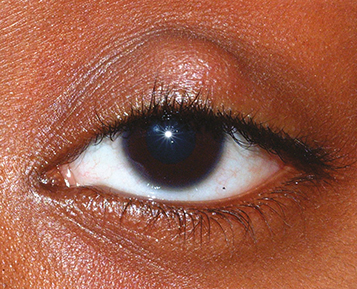(see Figure 6.7.1.)
Visible or palpable, well-defined, subcutaneous nodule in the eyelid. In some cases, a nodule cannot be identified.
Blocked meibomian gland orifice, eyelid swelling and erythema, focal tenderness. Associated with blepharitis, seborrheic dermatitis, and acne rosacea. May also note lesion coming to a head or draining mucopurulent material.
Definitions
Chalazion: Focal, tender, or nontender granulomatous inflammation within the eyelid secondary to obstruction of a meibomian gland or gland of Zeis. Typically not due to infection. May be acute, subacute, or chronic.
Hordeolum (i.e., stye): Acute, tender infection; can be external (abscess of a gland of Zeis or Moll on eyelid margin) or internal (abscess of the meibomian gland). Usually involves Staphylococcus species and occasionally evolves into preseptal cellulitis.
